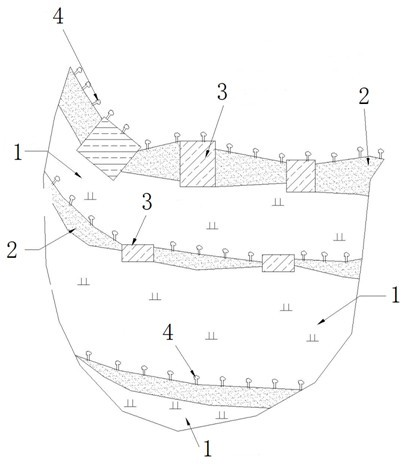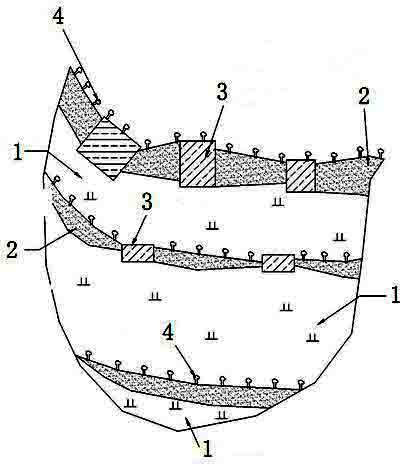Method for preventing and controlling water and soil loss of slope farmland on contra-dip slope in karst trough valley area
A technology for sloping farmland and trough valleys, applied in the field of soil erosion control, can solve problems such as increased soil gravel content, high investment in changing slopes to terraces, and reduced land production capacity, and achieves the effects of low cost, low cost, and convenient operation
- Summary
- Abstract
- Description
- Claims
- Application Information
AI Technical Summary
Problems solved by technology
Method used
Image
Examples
Embodiment 1
[0016] Example 1: "Field ridge + yellow flower hedge", in mid-September, the construction of "dirt ridge + yellow flower hedge" in the karst trough area against the slope slope, the yellow flower should be divided before transplanting, and the flower buds should be selected. , Good quality, 15-20-day-old plants with more tillers. Dig out all or part of the roots, separate the roots from the shortened stems according to the tiller nodes, and cut off the old roots. The roots can be cut short and transplanted as seedlings. Take the strip-like exposed rock formations on the reverse slope in the karst trough area as the ridge, and plant yellow flowers along the inner side of the ridge, with a hole distance of 25-35cm, using triangular or paired planting methods, 3-4 plants per hole, and transplanting Pay attention to the depth when planting, generally 15-17cm is better.
Embodiment 2
[0017] Example 2: "Ground ridge + vine plant fence", the propagation of vine is mainly by cuttings, and the cuttings are generally carried out in late spring and early summer or mid-to-early October. Collect semi-lignified healthy branches of the year without diseases and insect pests for cuttings. When cutting, cut the cuttings into 3-4cm long and leave 1-2 pairs of leaves. After cutting, immerse the whole cuttings with ABT rooting powder. ‰ solution, soak for 2-3 seconds, pick up and drain the water, and cuttage can be done after 2-3 hours. The depth of the branches inserted into the soil should be controlled at 1-1.5cm. When the moisture in the soil or matrix is insufficient, the film should be uncovered in the evening, watered thoroughly and then immediately covered and sealed. When more than 90% of the cuttings take root, the film can be gradually removed for ventilation, and foliar fertilizer should be sprayed. When it grows to 1-2 cm, it can be transplanted. Take the...
Embodiment 3
[0018] Example 3: "Field ridge + vetiver hedge", vetiver should be properly "cut" before planting, it is advisable to keep 20-30cm above the ground of the seedlings, cut off the excess, and cut the roots of the seedlings to 5-10cm is appropriate. Vetiver is planted in two rows along the inner side of the ridge with the exposed rock formations in strips on the reverse slope in the karst trough area. The planting density can generally be determined as 22-30cm between plants and 10-15cm between rows. , with 4-5 tillers of vetiver as a clump to plant, and the vertical staggering of the vetiver seedlings in the upper and lower rows, in which any one plant in one line and the two plants adjacent to the left and right of the plant in the other line form a "pin" shape. After the seedlings survive, they can effectively intercept surface runoff and prevent slope erosion.
PUM
 Login to View More
Login to View More Abstract
Description
Claims
Application Information
 Login to View More
Login to View More - R&D
- Intellectual Property
- Life Sciences
- Materials
- Tech Scout
- Unparalleled Data Quality
- Higher Quality Content
- 60% Fewer Hallucinations
Browse by: Latest US Patents, China's latest patents, Technical Efficacy Thesaurus, Application Domain, Technology Topic, Popular Technical Reports.
© 2025 PatSnap. All rights reserved.Legal|Privacy policy|Modern Slavery Act Transparency Statement|Sitemap|About US| Contact US: help@patsnap.com


